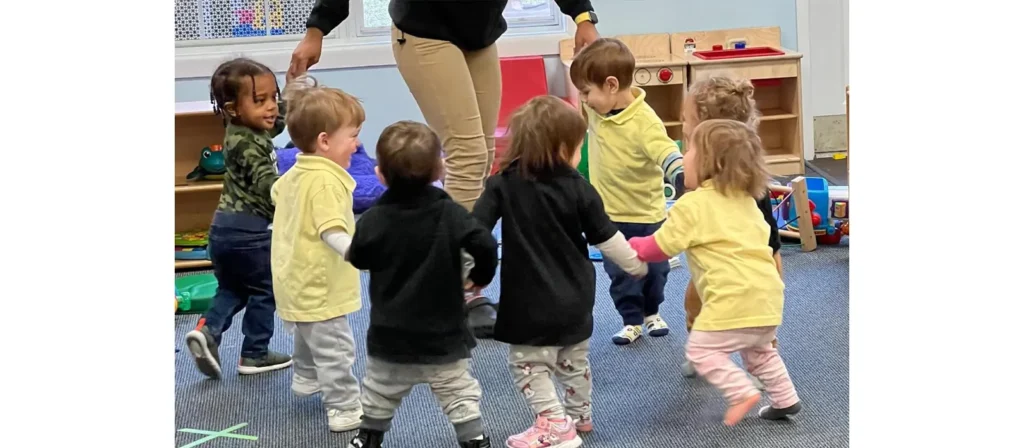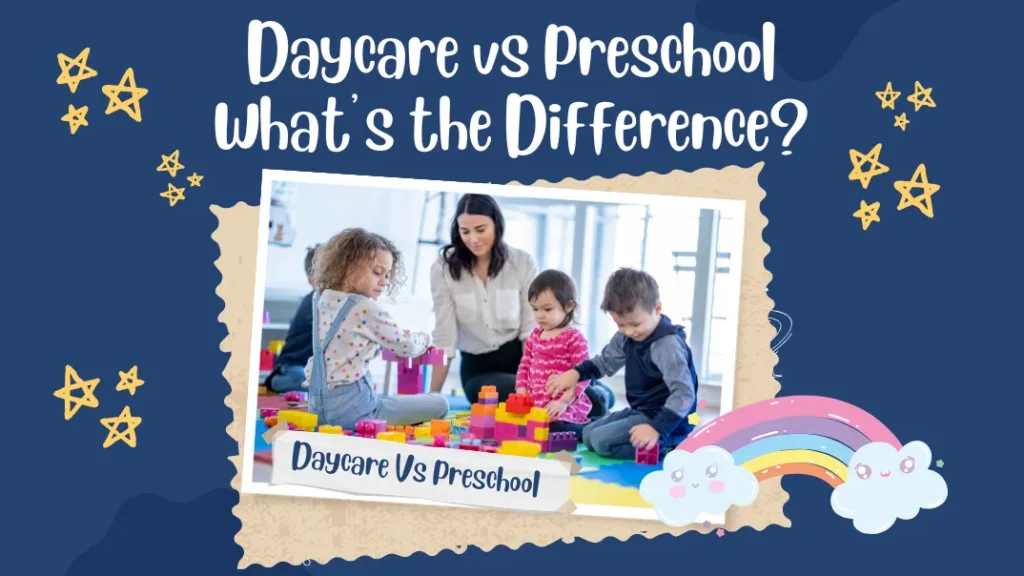Picking between daycare vs preschool can be confusing. Both sound like safe places for kids, but they don’t do the same thing. Daycare is mostly about care and flexibility. Preschool is more about early learning and preparing for kindergarten.
As a parent, you probably wonder:
- Is my child ready for preschool, or do they still need daycare?
- Which one costs more?
- How will the schedule fit into my day?
These are real questions every parent faces. The good news? Once you see the clear differences, the choice becomes much easier. This guide will walk you through what daycare offers, what preschool offers, how they compare, and how to decide which is right for your child.
What is Daycare?
Daycare is built for parents who need safe, all-day care while they’re at work. Most centers take children as young as 6 weeks old, all the way up to age 5.
Here’s what makes daycare unique:
- Wide age range: Babies, toddlers, and preschoolers can all be in daycare. That means lots of mixed ages in one place.
- Care comes first: Staff focus on feeding, naps, diaper changes, and safe play. Some daycares add little lessons, but learning isn’t the main goal.
- Flexible schedules: Many centers open early and close late, so parents can drop off and pick up around their work hours. Some even allow part-time or drop-in days.
- Trained caregivers: Workers are usually trained in child care and safety. They may not always have teaching degrees, but they know how to keep kids safe, happy, and engaged.
A typical daycare classroom is cozy and practical. You’ll see cribs, nap mats, soft play areas, and shelves filled with blocks, dolls, and art supplies. The setup is all about safety and easy supervision—caregivers can see children no matter where they are in the room.
Some families also choose home daycare vs preschool. Home daycare feels more like a family environment, with smaller groups of children cared for in someone’s home. It’s often cheaper and more flexible, but may not have the same resources as larger centers.
Daycare is the right choice if your child is still very young, needs all-day supervision, or isn’t quite ready for structured learning. It’s also a lifesaver for parents with full-time jobs and long hours.
What Is Preschool?
Preschool is for children who are a little older, usually ages 3 to 5. Unlike daycare, preschool is not just about care. It’s about early learning and helping kids get ready for kindergarten.
Here’s what makes preschool different:
- Learning focus: Kids practice letters, numbers, shapes, and colors. They also learn how to sit in a group, follow directions, and work with classmates.
- Shorter hours: Many preschools run half-day programs (for example, 9 AM to 12 PM). Some offer full-day preschool, but the schedule usually follows the school year instead of year-round like daycare.
- Special training: A preschool teacher vs a daycare caregiver often has more education in child development. This means they can guide structured learning activities.
- Social growth: Preschool helps children make friends, share, take turns, and build confidence in group settings.
A typical preschool classroom looks more like a mini-school. There are small tables and chairs for group work, bookshelves for reading, art corners with easels, and rugs for circle time. Shelves are low so children can grab toys or supplies on their own, teaching independence.
Preschool works best when your child is toilet-trained and ready for more structure. If you’re comparing preschool vs daycare cost, remember that preschool is sometimes cheaper, especially if it’s part of a public school program. But private preschools can cost as much—or even more—than daycare, depending on location.

Key Differences Between Daycare vs Preschool
At this point, you may be asking: What’s the real difference between daycare and preschool? The answer comes down to age, goals, schedule, and cost.
| Feature | Daycare | Preschool |
|---|---|---|
| Age Range | Infants to age 5 | Ages 3 to 5 |
| Main Focus | Care, play, safety | Early learning, school readiness |
| Schedule | Full-day, year-round, very flexible | Half-day or school-day, school-year only |
| Teachers | Caregivers trained in childcare and safety | Teachers trained in early childhood education |
| Toilet Training | Not required | Usually required before enrollment |
| Cost | Often higher, covers longer hours and infants | May be cheaper if public, private varies |
- Daycare = care, long hours, flexible, good for babies and toddlers.
- Preschool = learning, shorter hours, structured, good for 3–5 year olds.
Benefits of Daycare and Preschool
Both daycare and preschool help children grow, but in different ways. Knowing the benefits of each makes it easier to choose the right one.
Benefits of Daycare
- Flexibility for parents: Daycare centers are usually open early and close late. They often stay open during holidays and the summer. Perfect for working parents with long hours.
- Wide age range: From babies to 5-year-olds, all children can attend daycare. This makes it easier for families with more than one child.
- Basic routines: Children learn to eat with others, nap on time, and adjust to group settings.
- Social exposure: Even toddlers play and interact with others, learning how to share and cooperate.
- Safe environment: Furniture and toys are chosen for safety—soft mats, sturdy cribs, and age-appropriate play equipment.
Benefits of Preschool
- School readiness: Preschool focuses on early learning, so children practice numbers, letters, and group lessons.
- Structured routine: A set schedule helps children get used to the flow of a school day.
- Confidence and independence: Kids learn to do small tasks themselves—putting away toys, choosing activities, or joining circle time.
- Trained teachers: With backgrounds in early childhood education, teachers know how to prepare children for kindergarten.
- Focused social skills: Preschoolers learn to follow rules, wait their turn, and express emotions in healthy ways.
Daily Schedules
One of the biggest differences between daycare vs preschool is the daily schedule. Parents should think about which one fits their family life best.
Typical Daycare Schedule (Full-Day)
- 7:30–9:00 AM: Drop-off and free play
- 9:00–9:30 AM: Snack time
- 9:30–10:30 AM: Outdoor play or group activity
- 10:30–11:30 AM: Story time, songs, or circle play
- 11:30–12:00 PM: Lunch
- 12:00–2:00 PM: Nap or quiet time
- 2:00–3:00 PM: Art, blocks, or sensory play
- 3:00–3:30 PM: Snack
- 3:30–5:30 PM: Free play and pick-up
Daycare schedules are long and flexible, designed for children who stay all day.
Typical Preschool Schedule (Half-Day)
- 9:00–9:15 AM: Welcome and morning circle
- 9:15–10:00 AM: Learning centers (art, math, reading, dramatic play)
- 10:00–10:20 AM: Snack
- 10:20–10:50 AM: Outdoor play or recess
- 10:50–11:30 AM: Story, science, or group project
- 11:30–12:00 PM: Closing circle and dismissal
Preschool schedules are shorter and structured, making them more like school. Some full-day preschools add lunch, naps, and extended play, but the learning time stays central.
Daycare schedule vs preschool schedule: Daycare is built for parents’ working hours. Preschool is built for children’s learning routines.

Classroom Environment: Daycare vs Preschool
One of the most noticeable differences between daycare and preschool is the classroom environment. While both are designed to keep children safe and engaged, the way spaces are organized reflects their different purposes.
Daycare classrooms
Usually feel more flexible and home-like. They often have open play areas, nap corners, and multipurpose spaces where children can eat, play, and rest. Furniture tends to be simple and sturdy, suited for long hours and younger children. The environment is less about separating activities and more about creating a safe, welcoming space where routines can flow throughout the day.
Preschool classrooms
On the other hand, they are more structured. Rooms are often divided into learning zones: a reading area with low shelves, an art corner with tables, and a rug for group activities like circle time. This layout mirrors the transition toward formal education. Children begin to associate certain spaces with specific kinds of learning, which helps them develop focus and independence.
For parents, noticing these contrasts can make the choice clearer: daycare settings are geared toward care and comfort, while preschool environments lean more toward preparation for school routines. For educators, these design tendencies highlight the gradual shift from care-centered spaces to learning-centered spaces.
👉 If you’d like to see actual classroom floor plans for both daycare and preschool, check out our detailed guide: [Preschool and Daycare Classroom Layouts].
Daycare vs Preschool: Cost Breakdown
For many families, the question of daycare vs preschool isn’t just about age or learning—it’s also about money. Costs can vary widely depending on location, type of program, and how many hours your child attends.
Daycare Costs
- Longer hours = higher price: Because daycare often runs 8–12 hours per day, it usually costs more than preschool.
- Infant care is most expensive: Babies need more one-on-one attention, so caregiver-to-child ratios are lower, raising the price.
- U.S. averages: Daycare can range from $800 to $1,500 per month per child. In large cities, it may exceed $2,000.
- Part-time options: Some daycares allow part-time enrollment, but hourly costs are often higher than full-day programs.
Preschool Costs
- Half-day programs: Many preschools run just 3–4 hours a day, making them cheaper than daycare.
- Public vs private: Public preschools, when available, are often free or very affordable. Private preschools may charge $300 to $1,000 per month, depending on hours and reputation.
- Extra fees: Some preschools add costs for supplies, snacks, or enrichment activities.
International Perspective
- Canada: Preschool is sometimes subsidized, while daycare remains expensive for infants and toddlers.
- Australia: Families choose between long daycare (similar to U.S. daycare) and preschool. Subsidies help lower costs.
- Europe: In countries like France or Germany, preschool is heavily funded by the government and is nearly universal.
Daycare costs more because of longer hours and infant care. Preschool may be cheaper, especially public programs, but it may not meet full-time childcare needs.
Which One Is Right for Your Child?
So, how do you decide between daycare vs preschool? Here’s a quick checklist to help:
1. Your Child’s Age
- Infants and toddlers (under 3) → Daycare is the best fit.
- 3–5 year olds → Preschool is ideal, especially if potty trained.
2. Toilet Training
- Not potty trained? → Daycare is more flexible.
- Potty trained? → Preschool is usually required.
3. Your Schedule
- Full-time working parents → Daycare offers long, reliable hours.
- Flexible or stay-at-home parents → Preschool is great for short, structured learning sessions.
4. Developmental Goals
- Need basic care, naps, and safe play? → Daycare.
- Ready for learning, routines, and social skills? → Preschool.
5. Budget
- Want full-day coverage? Expect daycare to cost more.
- Want affordable early education? Public preschool may be best.
For more, check our guide: [Preschool vs Kindergarten].
Conclusion
Choosing between daycare and preschool depends on your child’s age, your schedule, and your goals. Daycare offers flexibility and care for younger kids, while preschool focuses on early learning and school prep.
Both options help your child grow socially, emotionally, and mentally. The best choice is the one that fits your family’s life—and your child’s stage of development.
Still deciding between all three options? Don’t miss: [Daycare vs Preschool vs Kindergarten].
FAQs
Is daycare considered education?
Not really. Daycare is mainly about care and play. Some add learning activities, but preschool is designed for early education.
What’s the difference between a preschool teacher vs daycare caregiver?
Preschool teachers usually have training in early childhood education. Daycare caregivers focus more on keeping children safe, happy, and cared for.
Can my child attend both daycare and preschool?
Yes. Some families start with daycare, then switch to preschool around age 3. Some daycares even have preschool classrooms for older children.
Which helps more with social skills: daycare or preschool?
Both do. Daycare helps kids interact with mixed ages. Preschool helps kids practice rules, turn-taking, and teamwork in a school-like setting.
Do I need preschool before kindergarten?
It’s not required, but it helps. Children who attend preschool often adjust more smoothly to kindergarten.
What about daycare vs Montessori vs preschool?
Montessori preschools follow a special learning method where children choose activities. Daycare is more care-focused. Traditional preschool follows a teacher-led plan.
At what age should I switch from daycare to preschool?
Most parents switch around age 3, when children are ready for structured learning.
Is daycare more expensive than preschool?
Yes, usually. Daycare runs longer hours and accepts infants, which drives up costs.
Can 2-year-olds go to preschool?
Most preschools start at age 2.5 or 3. Daycare is usually the choice for younger toddlers.



